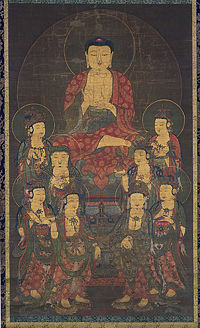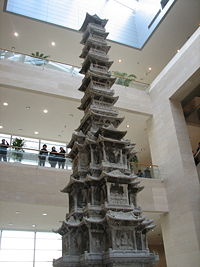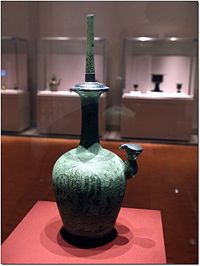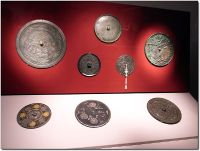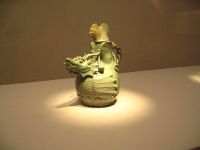Difference between revisions of "Goryeo" - New World Encyclopedia
Dan Davies (talk | contribs) (New page: {{claimed}} {{Infobox Former Country |native_name = {{lang|ko|고려국 (高麗國)}}<br /><small>{{lang|ko|고려왕조 (高麗王朝)}} |conventional_long_name = State of Goryeo |common_...) |
Sarah Davies (talk | contribs) (links fixed) |
||
| Line 17: | Line 17: | ||
| | | | ||
|event_start = Coronation of [[Wang Geon|Taejo]] | |event_start = Coronation of [[Wang Geon|Taejo]] | ||
| − | |date_start = | + | |date_start = June 15 918 |
|event_end = Abdication of [[Gongyang of Goryeo|Gongyang]] | |event_end = Abdication of [[Gongyang of Goryeo|Gongyang]] | ||
| − | |date_end = | + | |date_end = July 18 1392 |
| | | | ||
|event1 = [[Goryeo-Khitan Wars|Korea-Khitan Wars]] | |event1 = [[Goryeo-Khitan Wars|Korea-Khitan Wars]] | ||
| − | |date_event1 = | + | |date_event1 = 993 - 1019 |
|event2 = [[Mongol invasions of Korea|Mongolian invansions]] | |event2 = [[Mongol invasions of Korea|Mongolian invansions]] | ||
| − | |date_event2 = | + | |date_event2 = 1231 - 1270 |
|event3 = Completion of [[Tripitaka Koreana]] | |event3 = Completion of [[Tripitaka Koreana]] | ||
| − | |date_event3 = | + | |date_event3 = 1251 |
|event4 = | |event4 = | ||
|date_event4 = | |date_event4 = | ||
| | | | ||
|event_pre = [[Later Three Kingdoms]] rise | |event_pre = [[Later Three Kingdoms]] rise | ||
| − | |date_pre = | + | |date_pre = 892 |
| | | | ||
|<!--- Flag navigation: Preceding and succeeding entities p1 to p5 and s1 to s5 ---> | |<!--- Flag navigation: Preceding and succeeding entities p1 to p5 and s1 to s5 ---> | ||
| Line 63: | Line 63: | ||
|title_leader = [[Monarch|Wang]] | |title_leader = [[Monarch|Wang]] | ||
|leader1 = [[Wang Geon|Taejo]] | |leader1 = [[Wang Geon|Taejo]] | ||
| − | |year_leader1 = | + | |year_leader1 = 918 - 946 |
|leader2 = [[Gwangjong of Goryeo|Gwangjong]] | |leader2 = [[Gwangjong of Goryeo|Gwangjong]] | ||
| − | |year_leader2 = | + | |year_leader2 = 949 - 975 |
|leader3 = [[Wonjong of Goryeo|Wonjong]] | |leader3 = [[Wonjong of Goryeo|Wonjong]] | ||
| − | |year_leader3 = | + | |year_leader3 = 1259 - 1274 |
|leader4 = [[Gongmin]] | |leader4 = [[Gongmin]] | ||
| − | |year_leader4 = | + | |year_leader4 = 1351 - 1374 |
| | | | ||
|<!--- Area and population of a given year ---> | |<!--- Area and population of a given year ---> | ||
| Line 77: | Line 77: | ||
|footnotes = | |footnotes = | ||
}} | }} | ||
| − | The '''Goryeo Dynasty''', established in | + | The '''Goryeo Dynasty''', established in 918, united the [[Later Three Kingdoms]] in 935 and ruled [[Korea]] until replaced by the [[Joseon dynasty]] in 1392. Two of this period's most notable products are Goryeo pottery — the famous Korean [[celadon]] pottery — and the ''[[Tripitaka Koreana]]'' — the [[Buddhist]] scriptures (''[[Tripitaka]]'') carved onto roughly 80,000 woodblocks. Goryeo also created the world's first metal-based movable type [[printing press]] in 1234. |
The name "Goryeo" is a shortened form of "[[Goguryeo]]," one of the ancient [[Three Kingdoms of Korea]]. The English name "Korea" derives from "Goryeo." See also [[Names of Korea]]. | The name "Goryeo" is a shortened form of "[[Goguryeo]]," one of the ancient [[Three Kingdoms of Korea]]. The English name "Korea" derives from "Goryeo." See also [[Names of Korea]]. | ||
| Line 86: | Line 86: | ||
[[Silla]], which had united the [[Three Kingdoms of Korea]] in 668, weakened and lost control over local lords during the end of the 9th century. The country entered a period of civil war and rebellion, led by [[Gung Ye]], [[Gi Hwon]], [[Yang Gil]], and [[Gyeon Hwon]]. | [[Silla]], which had united the [[Three Kingdoms of Korea]] in 668, weakened and lost control over local lords during the end of the 9th century. The country entered a period of civil war and rebellion, led by [[Gung Ye]], [[Gi Hwon]], [[Yang Gil]], and [[Gyeon Hwon]]. | ||
| − | Gung Ye established Hugoguryeo (meaning "Later [[Goguryeo]]" | + | Gung Ye established Hugoguryeo (meaning "Later [[Goguryeo]]," renamed [[Taebong]]). Gyeon Hwon established [[Hubaekje]] (meaning "Later [[Baekje]]"). Together with the declining Silla, they are known as the [[Later Three Kingdoms of Korea|Later Three Kingdoms]]. |
===Founding=== | ===Founding=== | ||
| Line 97: | Line 97: | ||
The terminology used in the court of Goryeo adopted the system of an empire, not of a kingdom. The capital, [[Gaesong|Gaeseong]], was called "Imperial Capital" (황도, 皇都) and the palace was referred to as "Imperial Palace" (황성, 皇城). Other terms, such as "Your (Imperial) Majesty" (폐하, 陛下), "Prince" (태자, 太子), "Empress Dowager" (태후, 太后), and "Imperial Ordinance" (詔 or 勅) also suggest that Goryeo adopted the title system of an empire. However, Goryeo usually does not used the term of an "emperor(황제, 皇帝)" for rulers, instead a [[supreme king]] (대왕, 大王) was used for the rulers.But sometimes the term of an "emperor(황제, 皇帝)" or "emperor of the east of the ocean(해동천자, 海東天子)" were used. After the Mongol invasion, these terms were prohibited by Mongolian emperors. | The terminology used in the court of Goryeo adopted the system of an empire, not of a kingdom. The capital, [[Gaesong|Gaeseong]], was called "Imperial Capital" (황도, 皇都) and the palace was referred to as "Imperial Palace" (황성, 皇城). Other terms, such as "Your (Imperial) Majesty" (폐하, 陛下), "Prince" (태자, 太子), "Empress Dowager" (태후, 太后), and "Imperial Ordinance" (詔 or 勅) also suggest that Goryeo adopted the title system of an empire. However, Goryeo usually does not used the term of an "emperor(황제, 皇帝)" for rulers, instead a [[supreme king]] (대왕, 大王) was used for the rulers.But sometimes the term of an "emperor(황제, 皇帝)" or "emperor of the east of the ocean(해동천자, 海東天子)" were used. After the Mongol invasion, these terms were prohibited by Mongolian emperors. | ||
| − | In order to strengthen the power of the central government, [[Gwangjong of Goryeo|Gwangjong]], the fourth supreme king, made a series of laws including that of freeing slaves in | + | In order to strengthen the power of the central government, [[Gwangjong of Goryeo|Gwangjong]], the fourth supreme king, made a series of laws including that of freeing slaves in 958, and one creating the exam for hiring civil officials. |
| − | The fifth supreme [[Gyeongjong of Goryeo|king Gyeongjong]] ([[hangul]]: 경종, [[hanja]]: 景宗), launched land-ownership reformation called Jeonsigwa ([[hangul]]: 전시과, [[hanja]]: 田柴科) and the 6th supreme [[Seongjong of Goryeo|king Seongjong]] ([[hangul]]: 성종, [[hanja]]: 成宗) appointed officials to local areas, which were previously succeeded by the lords. Between | + | The fifth supreme [[Gyeongjong of Goryeo|king Gyeongjong]] ([[hangul]]: 경종, [[hanja]]: 景宗), launched land-ownership reformation called Jeonsigwa ([[hangul]]: 전시과, [[hanja]]: 田柴科) and the 6th supreme [[Seongjong of Goryeo|king Seongjong]] ([[hangul]]: 성종, [[hanja]]: 成宗) appointed officials to local areas, which were previously succeeded by the lords. Between 993 and 1019, the [[Goryeo-Khitan Wars]] ravaged the northern border. |
By the time of eleventh supreme [[Munjong of Goryeo|king Munjong]] ([[hangul]]: 문종, [[hanja]]: 文宗), the central government of Goryeo gained complete authority and power over local lords. Munjong and later supreme kings emphasized the importance of [[civilian control of the military|civilian leadership over the military]]. | By the time of eleventh supreme [[Munjong of Goryeo|king Munjong]] ([[hangul]]: 문종, [[hanja]]: 文宗), the central government of Goryeo gained complete authority and power over local lords. Munjong and later supreme kings emphasized the importance of [[civilian control of the military|civilian leadership over the military]]. | ||
| Line 112: | Line 112: | ||
===Power struggles=== | ===Power struggles=== | ||
| − | The House Yi of Inju (인주 이씨, 仁州李氏) married the supreme kings from Munjong to the 17th supreme king, [[Injong of Goryeo|Injong]]. Eventually the Yis gained more power than the supreme king himself. This led to the coup of [[Yi Ja-gyeom]] in | + | The House Yi of Inju (인주 이씨, 仁州李氏) married the supreme kings from Munjong to the 17th supreme king, [[Injong of Goryeo|Injong]]. Eventually the Yis gained more power than the supreme king himself. This led to the coup of [[Yi Ja-gyeom]] in 1126. The coup failed but the power of monarch was weakened; Goryeo underwent a civil war among the nobility. |
| − | In | + | In 1135, [[Myo Cheong]] argued to move the capital to Seogyeong (present day [[Pyongyang|P'yŏngyang]]). This proposal divided the nobilities of Goryeo in half. One faction, led by Myo Cheong, believed in moving the capital to Pyongyang and expanding into [[Manchuria]]. The other one, led by [[Kim Bu-sik]] (author of the ''[[Samguk Sagi]]''), wanted to keep the status quo. Myo Cheong failed to persuade the King and rebelled against the central government, but failed and was killed. |
| − | In | + | In 1170, a group of army officers led by [[Jeong Jung-bu]] (정중부, 鄭仲夫) and [[Yi Ui-bang]] (이의방, 李義方), launched a [[coup d'état]] and succeeded. [[Injong of Goryeo|supreme king Injong]] went into exile and [[Myeongjong of Goryeo|supreme king Myeongjong]] (명종,明宗) was made a king. Effective power, however, lay with a succession of generals: Military rule of Goryeo had begun. In 1177, the young general [[Kyong Taesung]] rose to power and began an attempt to restore the full power of the monarch and purge the corruption of the state. However, he died in 1184, and was succeeded by the son of a slave [[Yi Ui-min]]. His unrestrained corruption and cruelty led to a coup by a more traditionalist general, [[Choi Chungheon]], who assassinated Yi Uimin and took supreme power in 1197. For the next 61 years, the Choe house ruled as military dicators, maintaining the supreme kings as puppet monarchs; Choe Chungheon was succeeded in turn by his son [[Choi U]], his grandson [[Choi Hang]] and his great-grandson [[Choi Ui]]. On taking power, Choi Chungheon forced Meyongjong off the throne and replaced him by [[Sinjong of Goryeo|Supreme king Sinjong]], but after Sinjong died he forced two further kings off the throne until he found the pliable [[Gojong of Goryeo|king Gojong]]. |
===Mongol invasions (1231 - 1259)=== | ===Mongol invasions (1231 - 1259)=== | ||
| Line 125: | Line 125: | ||
===Last reform=== | ===Last reform=== | ||
[[Image:Ddol-mangC.jpg|200px|left|thumb|bronze ritual vessel]] | [[Image:Ddol-mangC.jpg|200px|left|thumb|bronze ritual vessel]] | ||
| − | Goryeo was dominated by the Mongol [[Yuan Dynasty]] when [[Gongmin of Goryeo|King Gongmin]] took over the throne. He was forced to spend many years in the Yuan court, being sent there in 1341 as a virtual prisoner before becoming a king. He married the Mongol princess [[Nogukdaejang Gongju]] (노국대장공주, 魯國大長公主). But in the mid-14th century Yuan was beginning to crumble, soon to be replaced by the [[Ming dynasty]] in 1368. Gongmin began efforts to reform Goryeo government. His first act was to remove all pro-Mongol aristocrats and military officers from their positions. and King Gongmin attack the Yuan. Mongols had annexed northern provinces of Korea after the invasions and incorporated them into their empire as [[South Hamgyong|Ssangseong]] (쌍성총관부, 雙城摠管府) and [[North Pyongan|Dongnyeong]] (동녕부, 東寧府). Goryeo army retook these province partly thanks to defection from [[Yi Ja-chun]], a minor Korean official in service of Mongols in Ssangseong, and his son [[Yi Seonggye]]. also general Yi Seonggye and [[Ji Yongsu]] campaign in [[Liaoyang]]. but after the death of his wife Nogukdaejang Gongju in | + | Goryeo was dominated by the Mongol [[Yuan Dynasty]] when [[Gongmin of Goryeo|King Gongmin]] took over the throne. He was forced to spend many years in the Yuan court, being sent there in 1341 as a virtual prisoner before becoming a king. He married the Mongol princess [[Nogukdaejang Gongju]] (노국대장공주, 魯國大長公主). But in the mid-14th century Yuan was beginning to crumble, soon to be replaced by the [[Ming dynasty]] in 1368. Gongmin began efforts to reform Goryeo government. His first act was to remove all pro-Mongol aristocrats and military officers from their positions. and King Gongmin attack the Yuan. Mongols had annexed northern provinces of Korea after the invasions and incorporated them into their empire as [[South Hamgyong|Ssangseong]] (쌍성총관부, 雙城摠管府) and [[North Pyongan|Dongnyeong]] (동녕부, 東寧府). Goryeo army retook these province partly thanks to defection from [[Yi Ja-chun]], a minor Korean official in service of Mongols in Ssangseong, and his son [[Yi Seonggye]]. also general Yi Seonggye and [[Ji Yongsu]] campaign in [[Liaoyang]]. but after the death of his wife Nogukdaejang Gongju in 1365, he got depressed in sadness. In the end, he was indifferent to politics. and entrusted with a great task to a monk [[Shin Don]] (신돈, 辛旽). but after six years, Shin Don lost his position. In the end, he was killed by his favorite young men, shattering his dream and putting Goryeo on the road to collapse. |
===Fall=== | ===Fall=== | ||
Revision as of 17:56, 10 July 2007
| |||||||||||||||||||||||||||||||||||||||||||
The Goryeo Dynasty, established in 918, united the Later Three Kingdoms in 935 and ruled Korea until replaced by the Joseon dynasty in 1392. Two of this period's most notable products are Goryeo pottery — the famous Korean celadon pottery — and the Tripitaka Koreana — the Buddhist scriptures (Tripitaka) carved onto roughly 80,000 woodblocks. Goryeo also created the world's first metal-based movable type printing press in 1234.
The name "Goryeo" is a shortened form of "Goguryeo," one of the ancient Three Kingdoms of Korea. The English name "Korea" derives from "Goryeo." See also Names of Korea.
History
Background
Silla, which had united the Three Kingdoms of Korea in 668, weakened and lost control over local lords during the end of the 9th century. The country entered a period of civil war and rebellion, led by Gung Ye, Gi Hwon, Yang Gil, and Gyeon Hwon.
Gung Ye established Hugoguryeo (meaning "Later Goguryeo," renamed Taebong). Gyeon Hwon established Hubaekje (meaning "Later Baekje"). Together with the declining Silla, they are known as the Later Three Kingdoms.
Founding
Wang Geon, who was a lord of Songak (present-day Gaesong), joined Taebong but overthrew Gung Ye and established Goryeo in 918. [2]
The Later Three Kingdoms era ended as Goryeo annexed Silla in 935 and defeated Hubaekje in 936. Wang Geon moved the capital to his hometown Gaeseong, and ruled the Korean peninsula as the first king of Goryeo.
|
Jeulmun Period
|
Political structure
The terminology used in the court of Goryeo adopted the system of an empire, not of a kingdom. The capital, Gaeseong, was called "Imperial Capital" (황도, 皇都) and the palace was referred to as "Imperial Palace" (황성, 皇城). Other terms, such as "Your (Imperial) Majesty" (폐하, 陛下), "Prince" (태자, 太子), "Empress Dowager" (태후, 太后), and "Imperial Ordinance" (詔 or 勅) also suggest that Goryeo adopted the title system of an empire. However, Goryeo usually does not used the term of an "emperor(황제, 皇帝)" for rulers, instead a supreme king (대왕, 大王) was used for the rulers.But sometimes the term of an "emperor(황제, 皇帝)" or "emperor of the east of the ocean(해동천자, 海東天子)" were used. After the Mongol invasion, these terms were prohibited by Mongolian emperors.
In order to strengthen the power of the central government, Gwangjong, the fourth supreme king, made a series of laws including that of freeing slaves in 958, and one creating the exam for hiring civil officials.
The fifth supreme king Gyeongjong (hangul: 경종, hanja: 景宗), launched land-ownership reformation called Jeonsigwa (hangul: 전시과, hanja: 田柴科) and the 6th supreme king Seongjong (hangul: 성종, hanja: 成宗) appointed officials to local areas, which were previously succeeded by the lords. Between 993 and 1019, the Goryeo-Khitan Wars ravaged the northern border.
By the time of eleventh supreme king Munjong (hangul: 문종, hanja: 文宗), the central government of Goryeo gained complete authority and power over local lords. Munjong and later supreme kings emphasized the importance of civilian leadership over the military.
Internal disorder and Wars
Khitan invasions (993 - 1019)
- See main article: Goryeo-Khitan Wars
In 993, the Khitan invaded Goryeo's northwest border with 800,000 troops. The Khitan withdrew and ceded territory to the east of the Yalu River when Goryeo agreed to end its alliance with Song China. However, Goryeo continued to communicate with Song, having strengthened its position by building fortress in the newly gained northern territories. Meanwhile, In 1009, General Gang Jo of Goryeo led a coup against King Mokjong killing the king and establishing military rule. In 1010, The Khitan attacked again during an internal Goryeo power struggle. Gang Jo blocked the Liao invasions until his own death. The Goryeo king Hyeonjong was forced to flee the capital temporarily, but unable to establish a foothold and fearing a counterattack, the Khitan forces withdrew. In 1018, Khitan third invades. General Gang Gamchan ordered the stream blocked until the Khitans began to cross it, and when the Khitans were mid-way across, he ordered that the dam be destroyed so that the water would drown much of the Khitan army. The damage was great, General Gang led a massive attack that annihilated all the Khitan army. Barely a few thousand of the Liao troops survived after the bitter defeat at Kwiju.
After Gang Gamchan came General Yoon Gwan, who destroyed the Jurchens armies and expanded the Goryeo territory for a temporary time.
Power struggles
The House Yi of Inju (인주 이씨, 仁州李氏) married the supreme kings from Munjong to the 17th supreme king, Injong. Eventually the Yis gained more power than the supreme king himself. This led to the coup of Yi Ja-gyeom in 1126. The coup failed but the power of monarch was weakened; Goryeo underwent a civil war among the nobility.
In 1135, Myo Cheong argued to move the capital to Seogyeong (present day P'yŏngyang). This proposal divided the nobilities of Goryeo in half. One faction, led by Myo Cheong, believed in moving the capital to Pyongyang and expanding into Manchuria. The other one, led by Kim Bu-sik (author of the Samguk Sagi), wanted to keep the status quo. Myo Cheong failed to persuade the King and rebelled against the central government, but failed and was killed.
In 1170, a group of army officers led by Jeong Jung-bu (정중부, 鄭仲夫) and Yi Ui-bang (이의방, 李義方), launched a coup d'état and succeeded. supreme king Injong went into exile and supreme king Myeongjong (명종,明宗) was made a king. Effective power, however, lay with a succession of generals: Military rule of Goryeo had begun. In 1177, the young general Kyong Taesung rose to power and began an attempt to restore the full power of the monarch and purge the corruption of the state. However, he died in 1184, and was succeeded by the son of a slave Yi Ui-min. His unrestrained corruption and cruelty led to a coup by a more traditionalist general, Choi Chungheon, who assassinated Yi Uimin and took supreme power in 1197. For the next 61 years, the Choe house ruled as military dicators, maintaining the supreme kings as puppet monarchs; Choe Chungheon was succeeded in turn by his son Choi U, his grandson Choi Hang and his great-grandson Choi Ui. On taking power, Choi Chungheon forced Meyongjong off the throne and replaced him by Supreme king Sinjong, but after Sinjong died he forced two further kings off the throne until he found the pliable king Gojong.
Mongol invasions (1231 - 1259)
- See main article: Mongol invasions of Korea
In 1231, Mongolians under Ögedei Khan invaded Goryeo, as part of a general campaign to conquer China. The royal court moved to Ganghwa Island in the Bay of Gyeonggi, in 1232. The military ruler of the time Choe Chung-heon (최충헌, 崔忠獻) insisted on fighting back. Goryeo resisted for about 30 years but finally sued for peace in 1259. Meanwhile, the Mongols began a campaign that ravaged parts of Gyeongsang and Jeolla Provinces. Civilian resistance was strong, and the Imperial Court at Ganghwa attempted to strengthen its fortress. Korea won several victories but the Korean military could not withstand the waves of invasions. In 1236, Gojong ordered the re-creation of the Tripitaka Koreana, destroyed during the 1232 invasion. This collection of Buddhist scriptures took 15 years to carve on some 81,000 wooden blocks, and is preserved to this day. on the one hand March 1258, the dictator Choi was assassinated by Kim Jun. Thus, the dictatorship by military group was ended, and then the scholars who had insisted peace with Mongol gained power. Eventually, the scholars sent an envoy to Mongol, and a peace treaty was contracted between Mongol and Goryeo. Some military officials who refused to surrender formed the Sambyeolcho Rebellion and resisted in the islands off the southern shore of the Korean peninsula. For about 30 years of war, the Mongols could not conquer Goryeo. The war ended when the peace treaty was concluded after the dictator Choi was murdered by the literary men[1]. The treaty permitted the sovereign power and traditional cultures of Goryeo, and implied that the Mongols gave up conquering Goryeo under Mongolia's direct control[2] After the peace treaty with the Mongols, the Mongols planned to attack Japan by allying Mongol and Goryeo troops; however, it failed due to a heavy storm.
Last reform
Goryeo was dominated by the Mongol Yuan Dynasty when King Gongmin took over the throne. He was forced to spend many years in the Yuan court, being sent there in 1341 as a virtual prisoner before becoming a king. He married the Mongol princess Nogukdaejang Gongju (노국대장공주, 魯國大長公主). But in the mid-14th century Yuan was beginning to crumble, soon to be replaced by the Ming dynasty in 1368. Gongmin began efforts to reform Goryeo government. His first act was to remove all pro-Mongol aristocrats and military officers from their positions. and King Gongmin attack the Yuan. Mongols had annexed northern provinces of Korea after the invasions and incorporated them into their empire as Ssangseong (쌍성총관부, 雙城摠管府) and Dongnyeong (동녕부, 東寧府). Goryeo army retook these province partly thanks to defection from Yi Ja-chun, a minor Korean official in service of Mongols in Ssangseong, and his son Yi Seonggye. also general Yi Seonggye and Ji Yongsu campaign in Liaoyang. but after the death of his wife Nogukdaejang Gongju in 1365, he got depressed in sadness. In the end, he was indifferent to politics. and entrusted with a great task to a monk Shin Don (신돈, 辛旽). but after six years, Shin Don lost his position. In the end, he was killed by his favorite young men, shattering his dream and putting Goryeo on the road to collapse.
Fall
In 1388, King U and general Choe Yeong planned a campaign to invade present-day Liaoning of China. King U put the general Yi Seong-gye (later Taejo) in charge, but he stopped at the border and rebelled. Goryeo fell to General Yi In 1392. He then established the Joseon Dynasty.
Culture
Tripitaka Koreana
Goryeo celadon
Buddhism
ReferencesISBN links support NWE through referral fees
See also
- The History of the Koryo Dynasty[1](高麗史, the 1st source written in Chinese, the file type is PDF.) Seoul National Univ.
- List_of_Korean_monarchs#Goryeo
- Names of Korea
- List of Korea-related topics
- Korean Pottery: Categorized by Periods
Credits
New World Encyclopedia writers and editors rewrote and completed the Wikipedia article in accordance with New World Encyclopedia standards. This article abides by terms of the Creative Commons CC-by-sa 3.0 License (CC-by-sa), which may be used and disseminated with proper attribution. Credit is due under the terms of this license that can reference both the New World Encyclopedia contributors and the selfless volunteer contributors of the Wikimedia Foundation. To cite this article click here for a list of acceptable citing formats.The history of earlier contributions by wikipedians is accessible to researchers here:
The history of this article since it was imported to New World Encyclopedia:
Note: Some restrictions may apply to use of individual images which are separately licensed.
- ↑ The official history of Koryo, is printed by woodblock 1580.

